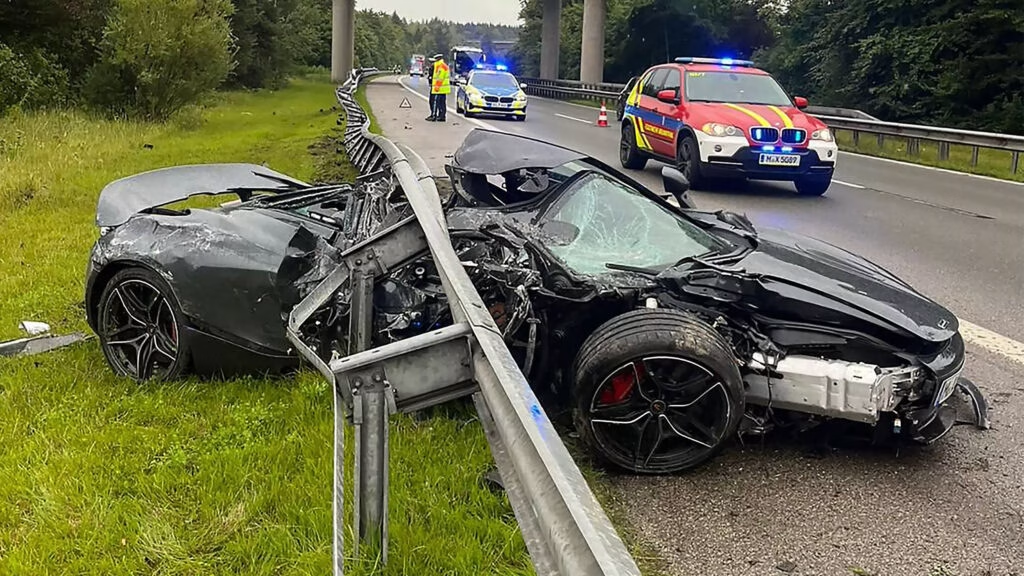How did a McLaren 720S end up destroyed on the Autobahn—and why did the driver walk away?
It’s the kind of photo that makes your stomach drop: a McLaren 720S, once the pride of British engineering, now twisted beneath a guardrail on a rain-slicked stretch of German highway. Yet the real story isn’t just the mangled carbon fiber—it’s the fact that the 61-year-old driver survived with barely a scratch. Let’s unpack what happened, why this crash didn’t end in tragedy, and what it says about both supercar safety and the realities of high-speed driving.
What went wrong on that rainy Bavarian morning?
Early on a Saturday, just outside Munich, the driver was navigating the overpass connecting the A8 to the A995. According to the Holzkirchen highway police, he entered a curve at a speed that simply didn’t match the wet conditions. The result? The McLaren lost traction, slid off the road, and ended up wedged under a guardrail. Photos from the scene are jaw-dropping—the metal barrier pierced the car’s cabin, reportedly missing the driver’s head by mere inches.
It’s not just a case of bad luck. German police specifically cited “inappropriate speed” for the weather as the main culprit. And while the Autobahn is famous for its stretches without speed limits, that freedom comes with a catch: drivers are still expected to adjust for rain, traffic, and visibility. According to the German Road Safety Council, wet roads increase stopping distances by up to 50%, and hydroplaning can occur at speeds as low as 80 km/h (about 50 mph) depending on tire tread and water depth.
How did the driver survive such a violent crash?
Here’s where the engineering magic comes in. The McLaren 720S is built around a carbon fiber monocoque—a rigid, lightweight shell designed to absorb and deflect impact forces away from the occupant. In this case, that structure likely saved the driver’s life. Emergency responders from the Brunnthal Volunteer Fire Department arrived expecting the worst, only to find the driver with minor injuries. He was treated at the scene and released, never even needing a trip to the hospital.
It’s a testament to how far supercar safety has come. Modern performance cars like the 720S are required to meet strict crash standards, even as they chase ever-higher horsepower figures. The 720S, for example, features advanced airbags, reinforced crash zones, and a cockpit designed to remain intact even in severe impacts. According to Euro NCAP, vehicles with carbon monocoque structures consistently outperform traditional steel chassis in side-impact and rollover scenarios.
What happens to a supercar after a crash like this?
There’s no sugarcoating it: this McLaren is almost certainly headed for the scrapyard. The carbon tub was compromised, the bodywork shredded, and the active rear wing—normally a marvel of aerodynamics—was frozen in its deployed position, a silent witness to the violence of the crash. Police estimated the damage at over €250,000 (about $290,000), which is more than enough to total most cars, even at this price point.
For insurance companies, supercars pose a unique challenge. Repairs are costly, parts are specialized, and structural damage to the monocoque is often a death sentence for the chassis. According to a 2023 report from the Association of British Insurers, claims involving high-end sports cars average nearly four times the payout of standard vehicles, largely due to the cost of materials and labor.
Why do high-performance cars like the 720S demand extra respect in bad weather?
Let’s be honest: 710 horsepower (530 kW) sent to the rear wheels is a recipe for excitement—and, if you’re not careful, disaster. The McLaren 720S, produced from 2017 to 2023, is a marvel of speed and agility, powered by a twin-turbocharged 4.0-liter V8 and a lightning-quick dual-clutch transmission. But all that performance comes with a caveat: even the best traction and stability systems can’t defy the laws of physics.
On wet roads, supercars are especially vulnerable. Wide, low-profile tires that grip like glue in the dry can turn into skis when water pools on the surface. And while electronic aids can help, they’re not a substitute for driver judgment. The German traffic authority ADAC notes that sports cars are overrepresented in single-vehicle accidents on wet roads, often due to overconfidence or underestimating the conditions.
What can everyday drivers learn from this Autobahn crash?
You don’t need to own a McLaren to take something away from this story. The key lesson is about matching your speed to the conditions, not just the speed limit. Rain, standing water, and cold pavement all reduce grip—sometimes dramatically. Even the most advanced car can’t save you if you push past the limits of the road.
It’s also a reminder of the importance of modern safety tech. If you’re shopping for a car, pay attention to crash ratings, structural design, and active safety features. And if you’re behind the wheel of something powerful, remember: respect the machine, but respect the road even more.
The big takeaway? Surviving a crash like this isn’t about perfection—it’s about smarter adjustments. Start with one change this week—maybe slowing down a bit in the rain or double-checking your tires—and you’ll likely spot the difference by month’s end. Sometimes, it’s the small tweaks that keep the story from turning tragic.

